+1 404-890-0713
empiricalknead@gmail.com
Available today: Open to 8:30pm
By Appointment Only: Availabilites to 8am-8pm M-Sa
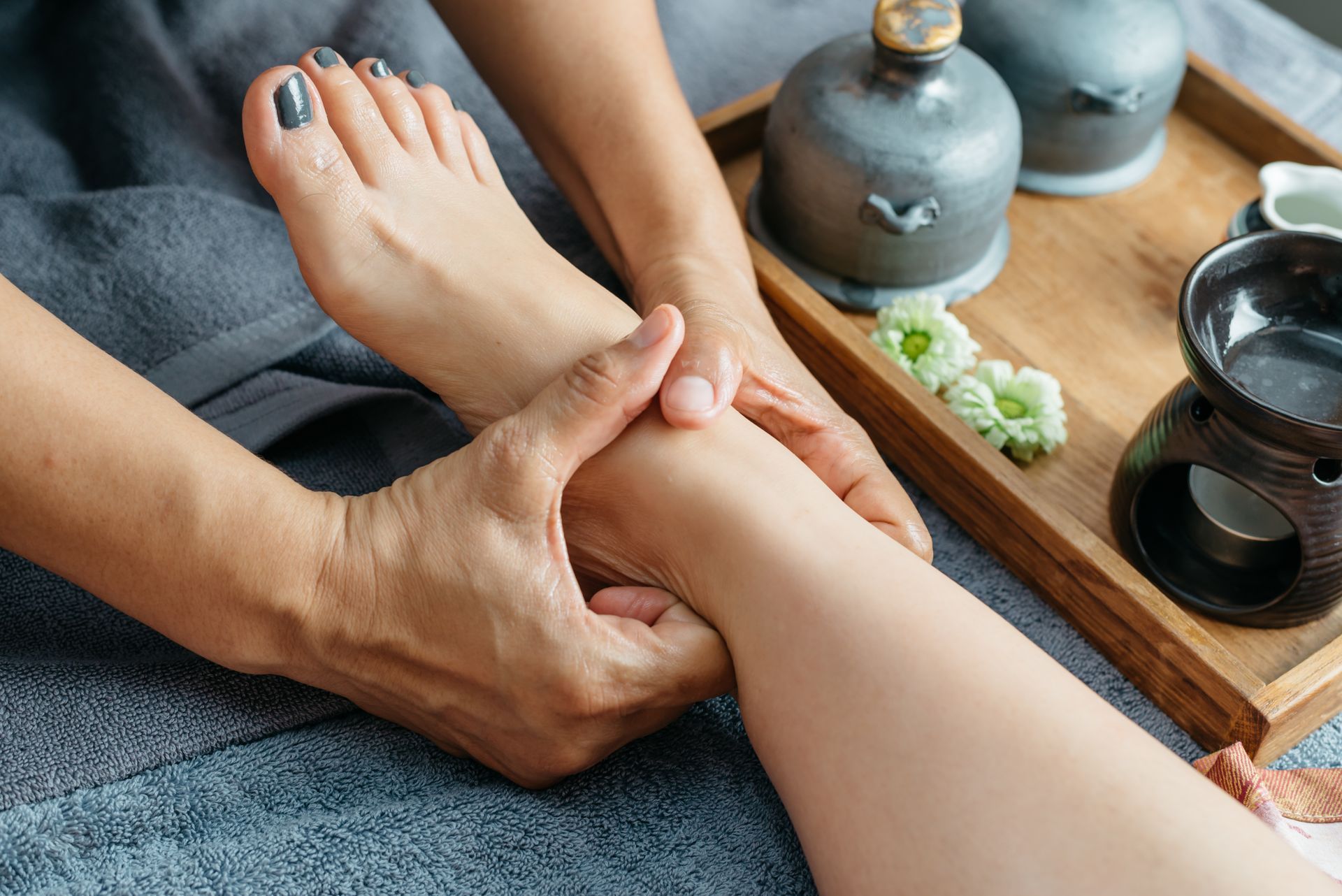
The Surprising Connection Between Foot Massages and Structural Imbalances
Who doesn’t love an amazing foot massage? The soothing kneading of tired, achy feet provides instant relief and relaxation. But what if your favorite foot massage is subtly causing—or worsening—back or hip pain? It sounds counterintuitive, but the connection between your feet and your overall structural health is more significant than you might realize.
The culprit lies in your arches, the pliable, foundational structures of your feet that support your body. These arches are not isolated—they’re connected to every part of your body through an intricate web of connective tissue called fascia. Fascia links muscles, bones, and organs into a unified system, which means that changes to your arches can ripple through your entire body.
When a massage focuses solely on the feet without considering the larger context of fascia and body mechanics, it can inadvertently disrupt the delicate balance of your arches, leading to structural imbalances and pain.
The Role of Fascia: Connecting Your Body from Head to Toe
What Is Fascia?
Fascia is a continuous, stretchy, yet firm connective tissue that weaves through and around your muscles, bones, tendons, ligaments, nerves, and organs. Imagine it as a 3D web that envelopes your entire body, connecting seemingly unrelated parts into a cohesive whole.
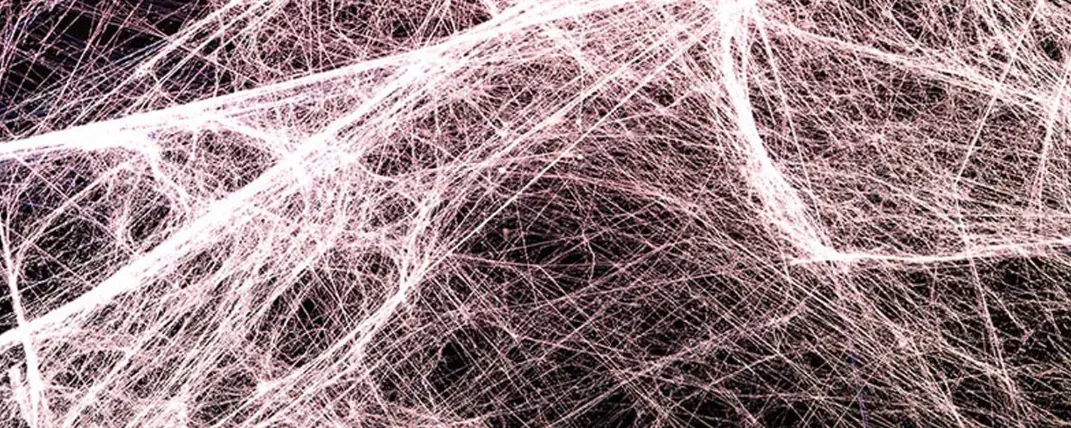
The fascia web network magnified
One of the most fascinating aspects of fascia is its responsiveness. It adapts to the forces you place on it—whether from movement, posture, or manual therapy. This adaptability is a double-edged sword: while it allows for incredible structural resilience, it also means fascia is susceptible to unintended imbalances.
For example, if you sit for long periods, your fascia molds to that posture, potentially leading to stiffness and restricted movement. Similarly, a repetitive foot massage applied without regard to the natural flow of fascia can create changes that affect your entire body.
When a massage focuses solely on the feet without considering the larger context of fascia and body mechanics, it can inadvertently disrupt the delicate balance of your arches, leading to structural imbalances and pain.
Fascia Lines: Pathways of Connection
Fascia is not random. Researchers like Thomas Myers have mapped it into distinct myofascial lines, which illustrate how tension and movement are distributed throughout the body. Key lines include:
- The Deep Front Line (DFL): This line connects the bottom of your feet to your head, passing through the arches, lower legs, hips, and spine includes your diaphragm, tongue and more as one piece of tissue linked together by fascia lines.
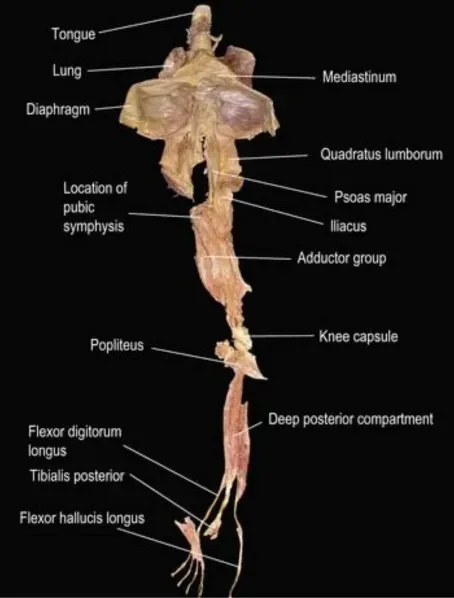
The figure illustrates the deep front line, which shows the continuous connection of myofascial tissue, from the muscles of the toes to the tongue The image is taken from Thomas Myers’ book: Anatomy Trains. Myofascial Meridians for Manual & Movement Therapists. Editor: Churchill Livingstone, 2013. Courtesy of Thomas Myers, co-author of the article.
- The Spiral Line: This pathway wraps around the body, crossing at the hips and linking the arches to the upper body.
These lines explain why a shift in your arches — whether caused by injury, posture, or even a massage — can affect distant areas like your back, hips, or shoulders.
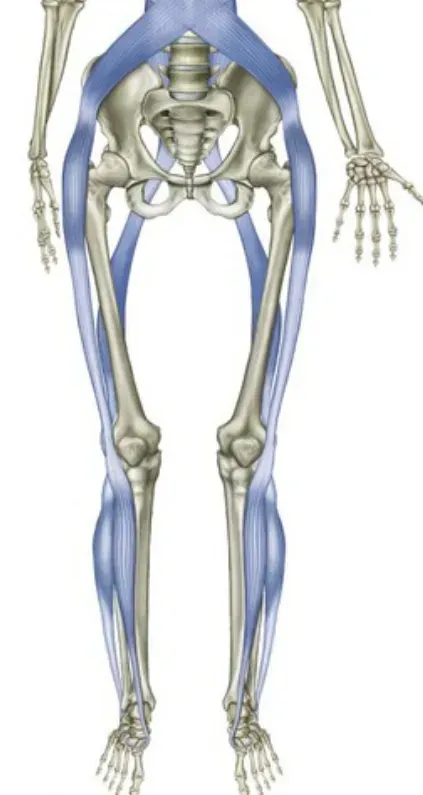
The lower body spiral line as defined by Tom Myers’ Anatomy Trains, illustrates the foot sling, the continuous connection of myofascial tissue that crosses over at hips and surrounds your upper body in a spiral line.
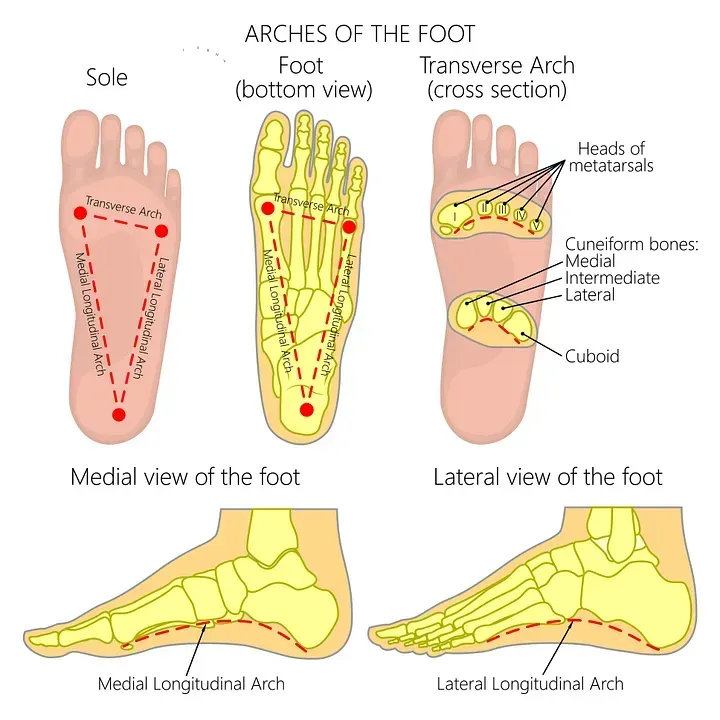
Arches of the foot
The Arches of the Feet: Your Body’s Foundation
Your feet contain three primary arches:
- Medial Arch: The inside arch, responsible for shock absorption.
- Lateral Arch: The outside arch, providing stability.
- Transverse Arch: The horizontal arch across the foot, supporting weight distribution.
Together, these arches form a tripod that supports your body’s weight and enables balanced movement. When functioning correctly, they create a stable foundation. But when imbalanced, the effects cascade throughout your body.
Common Arch Imbalances
1. Flat Feet (Pes Planus)
- Weak medial arches cause the foot to overpronate, leading to an inward tilt of the hips.
- This can stress the lower back, knees, and even the neck as your body compensates.
2. High Arches (Pes Cavus)
- Excessively high medial arches lead to oversupination, shifting weight to the outer edge of the foot.
- This often results in a hip tilt, increasing strain on the lower back and legs.
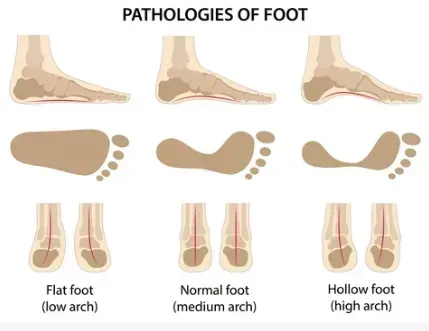
Causes of Arch Changes
Arch imbalances can develop from a variety of factors:
- Congenital Conditions: Some people are born with flat or high arches.
- Injury or Overuse: Sports injuries, sprains, or repetitive motion can alter the arches.
- Lifestyle Factors: Weight gain, poor footwear, and sedentary habits can contribute.
- Manual Therapy: Improperly performed massages can unintentionally alter arch integrity.
How Foot Massages Can Affect Your Arches
The Good: Health Benefits of Foot Massages
A well-executed foot massage can:
- Improve circulation.
- Relieve tension in the muscles and fascia.
- Reduce stress and promote relaxation.
These benefits are undeniable, but the effectiveness of a massage depends on the technique and understanding of the therapist.
The Risk: Disrupting Fascia Flow
If a massage therapist applies pressure to the arches without considering the fascia’s natural directional flow, they can inadvertently create imbalances. For example:
- High Arches: Excessive upward pressure on the medial arch can exaggerate the height of the arch, leading to over supination and hip tilts.
- Flat Feet: Downward pressure on the medial arch can further weaken it, causing over-pronation and joint strain.
These changes might seem minor, but even small shifts in the body’s foundation can have significant long-term effects, particularly when combined with dynamic forces like walking, running, or exercising.
The Fascia Connection: From Feet to Back Pain
A Chain Reaction

Changes in your arches affect the fascia lines running through your body. For instance:
- A high medial arch might increase tension in the Deep Front Line, pulling on the fascia around the hips and lower back.
- Flat feet might strain the Spiral Line, causing compensations in the knees, hips, and spine.
Delayed Symptoms
The effects of fascia imbalances are often delayed. You might feel fine immediately after a massage, but days or weeks later, you could notice:
- Tightness in the calves or hamstrings.
- Hip discomfort or stiffness.
- Lower back pain that seems to appear out of nowhere.
Beyond Massage: Caring for Your Arches
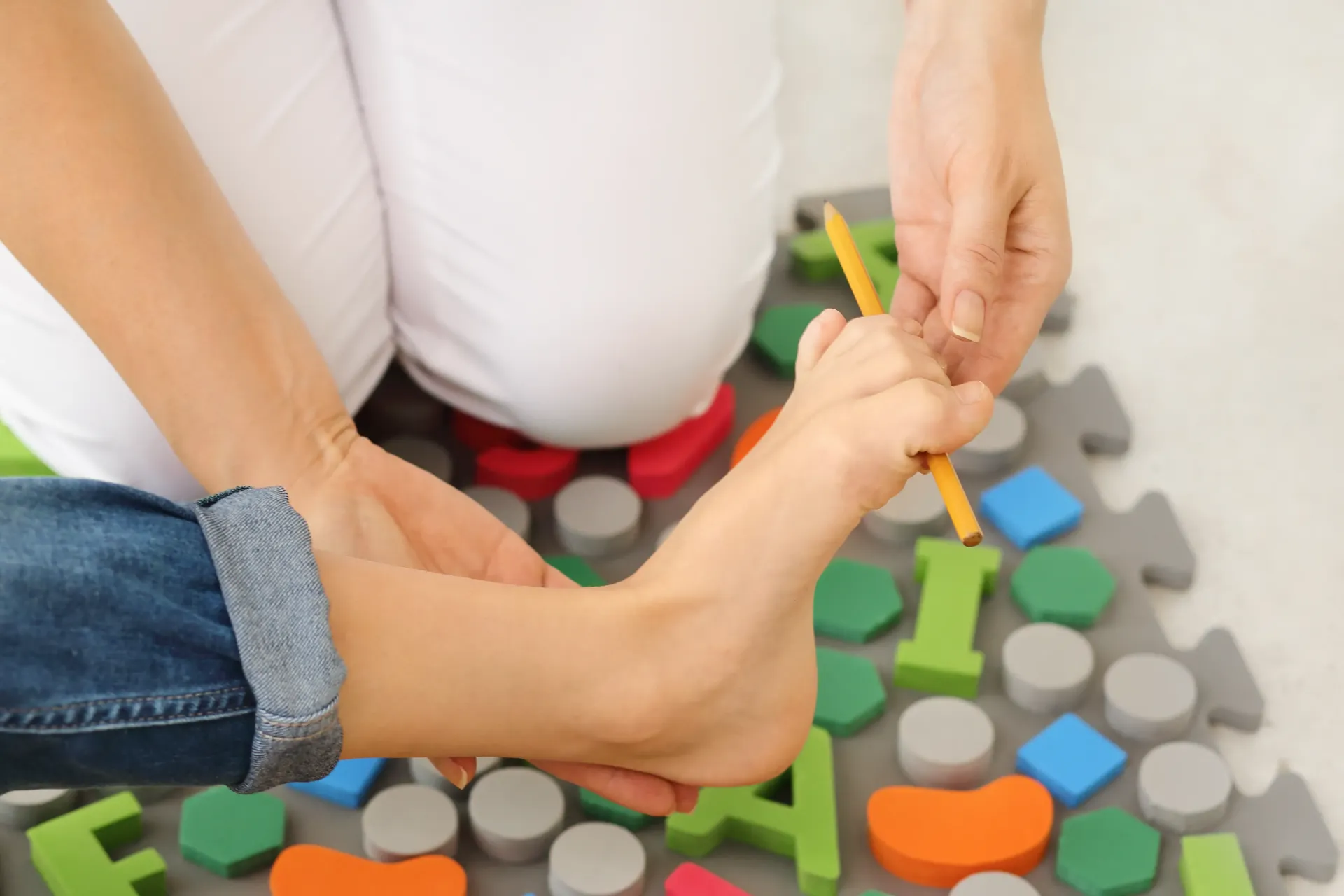
Strenthening Medial Arch
In addition to massage, you can support your arches through:
- Foot Exercises: Strengthen the intrinsic muscles of the feet with toe curls, arch lifts, and balance drills.
- Proper Footwear: Choose shoes with adequate arch support and cushioning.
- Stretching and Movement: Regular stretching, yoga, or Pilates can keep fascia pliable and balanced.
- Self-Care: Use tools like massage balls or foam rollers to release tension in the feet and lower legs.
Final Thoughts
Your feet are the foundation of your body, and their health directly impacts your overall structure. While foot massages can provide incredible relief, they must be performed with care and understanding of fascia’s complex connections.
At Empirical Knead we highly skilled therapist incorporating supportive practices, and staying mindful of your arches’ needs, where you can enjoy the benefits of therapeutic massage without compromising your structural integrity. Remember, a balanced body starts from the ground up.
Next… Let’s talk about your head!
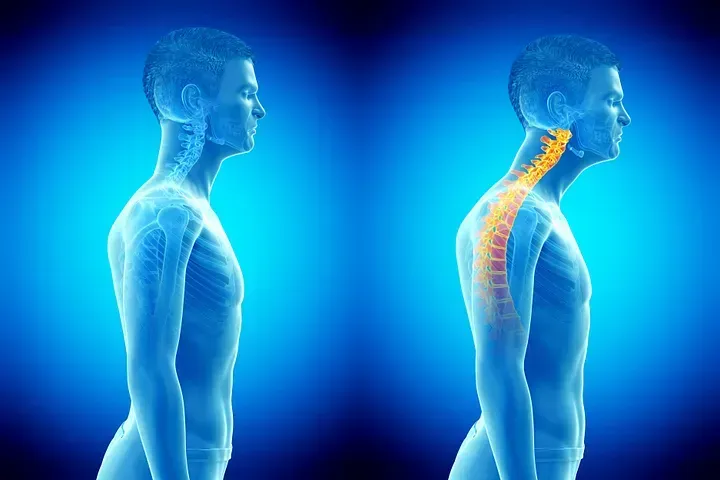
Forward Head Posture “Tech Neck” an unknown plague!
All Rights Reserved | Empirical Knead

